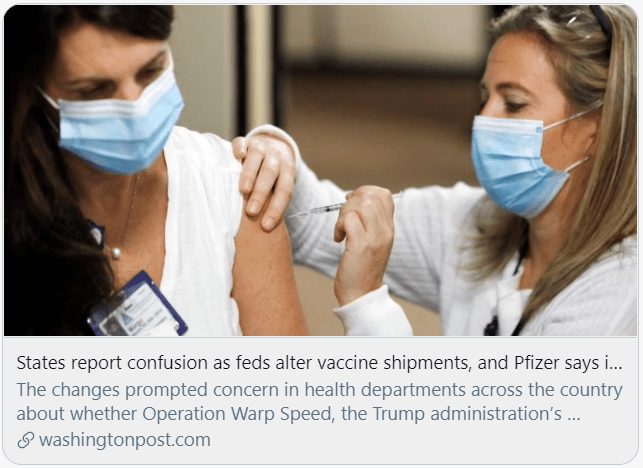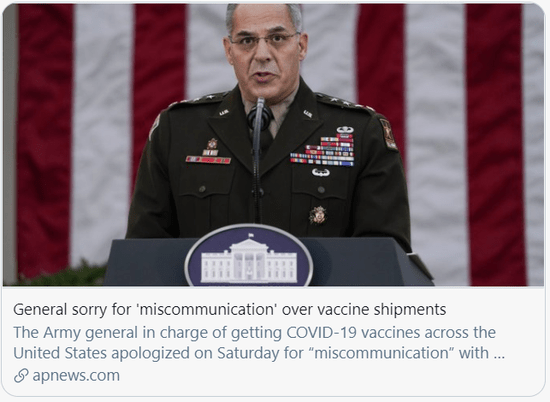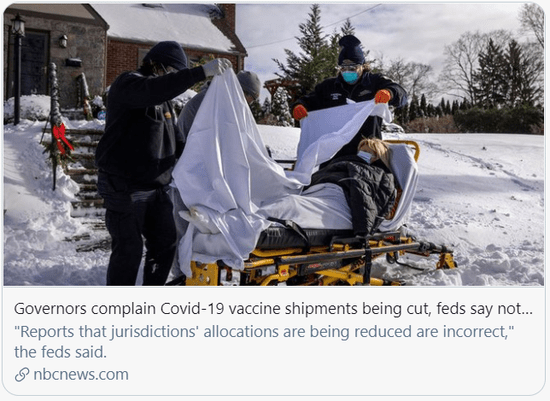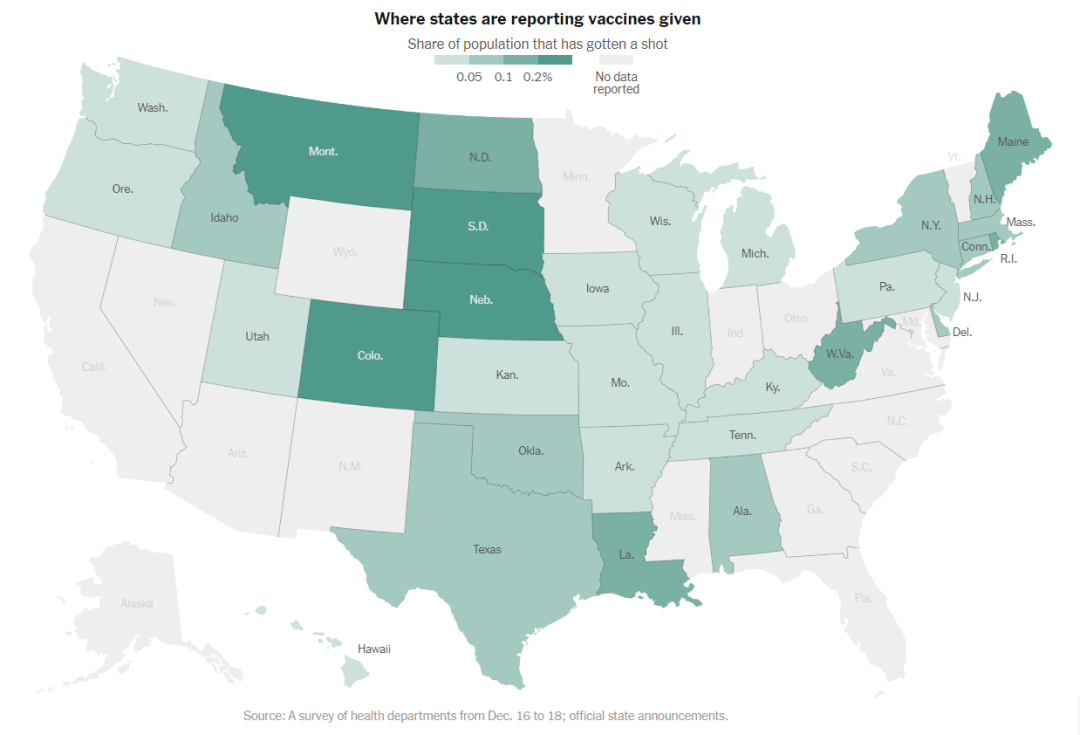The process of vaccine distribution in the United States can be described as “fating and downs”.
On December 14th local time, the United States officially began mass distribution and vaccination. So far, the distribution of vaccines has been frequent.
Many states reported adverse reactions after people were vaccinated; because the storage temperature during transportation was too low, vaccines destined for the two states had to be sent back to manufacturers. Now, the multi-state government has been told that the shipment of the second batch of vaccines will be significantly reduced.
The federal government said that this was due to Pfizer’s difficulties in production. Pfizer issued a statement to refute that vaccine production is normal.
December 19th local time, Gustav Perner, the general of the U.S. Army and head of Operation Warp Speed, a coronavirus vaccine and drug tackling program, apologized at a telephone briefing, saying that communication with the states was wrong.
According to the real-time statistics of Johns Hopkins University in the United States, as of the afternoon of December 20, Beijing time, there were 17,65591 confirmed cases of COVID-19 in the United States and 316,159 deaths.
According to the epidemic data released by the Centers for Disease Control and Prevention of the United States, on December 18, local time, more than 400,000 new confirmed cases of the novel coronavirus were reported in the United States, reaching 403,359, a record of nearly doubling the increase in the world’s highest number of new confirmed cases in a single day. Previously, the highest number of new confirmed cases in the United States in a single day was 244,011 reported on December 11.
The U.S. government disagrees with Pfizer.
According to The Washington Post, many state governors and health officials said they were told that the second week of vaccine shipments would be lower than expected, which confused many government officials.
The number of vaccine distributions in Washington State will be reduced by 40%; California, where cases are soaring, will reduce 160,000 doses; and Missouri will receive vaccines by 25% to 30% less than expected.
In addition to the states mentioned above, Connecticut, Georgia, Illinois, Kansas, Montana, Nebraska, Nevada, New Hampshire and Indiana were also told that vaccine shipments would be expected to decline significantly.

According to NBC, Alex Aza, Secretary of Health and Human Services, said Pfizer is addressing production challenges. Aza pointed out that Pfizer did not produce half of the number of vaccines expected.
December 15th local time, Florida Governor Ron DeSantis also issued a statement saying that Florida will reduce its supply of 450,000 doses of vaccine in the next few weeks due to Pfizer production problems.
Pfizer issued a statement rejecting the company’s production difficulties. “Pfizer has no production difficulties and no vaccine shipments have been suspended or delayed,” the statement said.
Last week, Pfizer successfully shipped 2.9 million doses of vaccines requested by the U.S. government to a designated location. At present, there are millions of doses of vaccines in the warehouse. However, Pfizer did not receive any shipping instructions for additional doses.
Perna: “I failed”
According to the Associated Press, on December 19th local time, Gustav Perner, the head of Operation Warp, a coronavirus vaccine and drug solution plan, admitted that he made a mistake in citing vaccine dose data.
Perner noted, “There is no problem with the production process, no problem with Pfizer vaccine, and no problem with the Moderna vaccine. However, there is a difference between vaccines that have been produced and vaccines that are ready for distribution.” The U.S. Department of Health and Human Services said that the finished vaccine must go through strict quality control and sterile testing before it can be put on the market for distribution, which may take up to a month.

“I failed, I’m adjusting [the vaccine distribution plan], I’m fixing the problem, and we’ll move forward,” Perner said during a teleconference.
Perner accepted the criticism and accusations of him. “I want to take personal responsibility for miscommunication,” he said. Perner added, “I know that no one has done this these days. But I am responsible. This is an extremely difficult task, and we have not done it perfectly.”
Multi-state vaccine distribution may be chaotic
According to CNN, a spokesman for the U.S. Department of Health and Human Services said that the number of vaccines received by states will not change, but it will take longer to distribute. The states will receive the vaccine from different locations within a few days, and it will take more than one more working days to distribute the vaccine. Perner said that the government is currently expected to provide about 20 million doses of vaccine to the states by the first week of January 2021, including Pfizer vaccine and the newly approved Moderna vaccine.
Two anonymous federal officials said that while states will eventually get the expected number of vaccines, misconceptions about vaccine availability and changes in vaccine delivery schedules may cause confusion in the states, according to ABC.
According to The Washington Post, health officials in many states say vaccine supply levels have fallen significantly than expected, forcing them to adjust their vaccine distribution plan for next week at the last minute. The Iowa Department of Health issued a statement saying that with the 30% reduction in the dose of vaccine distribution, the state health department will need some time to adjust the vaccine distribution plan and formulate the next step.

Multi-state health officials pointed out that the second batch of vaccines would begin to be vaccinated against residents who have long lived in nursing facilities.
But now they have to face a dilemma, whether to continue the original plan or complete the vaccination of medical personnel first. So far, a spokesman for the Maine Centers for Disease Control and Prevention has said that Maine will not be able to fully launch a vaccination program for residents and staff of all long-term care institutions next week.
The number of vaccines in multiple states is facing cuts, and Washington Governor Jay Inslee tweeted that “this is destructive and depressing news.
We need accurate and predictable figures to plan the vaccination program to ensure that the program is successfully implemented.”
Washington State Health Secretary Weisman said while he appreciated that Operation Warp only provided verified vaccine dose numbers, he noted that states cannot make plans without long-term expectations, according to The Washington Post.
With pharmaceutical companies and Operation Warp changing the criteria for predicting the number of vaccines, it is impossible to make a long-term plan.



